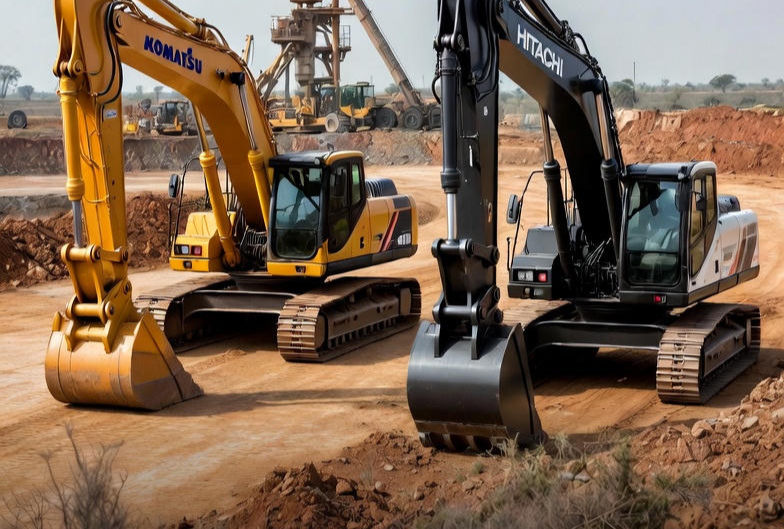The Lifecycle of a Used Swing Motor: From Scrap Heap to Site Hero
- RALPH COPE

- May 15
- 4 min read
Updated: May 19

How Vikfin Turns Junkyard Misfits into Heavy-Hitting Legends
You ever look at a crusty old excavator swing motor in a salvage yard and think, “Well, that’s definitely f*cked”? Same. But at Vikfin, we see potential.
Where others see greasy junk with 12 liters of hydraulic regret leaking out, we see a comeback story. Cue the inspirational music, because you’re about to witness the Rocky Balboa of excavator parts—the swing motor that came back from the dead.
In this blog, we’re walking you through the entire lifecycle of a used swing motor—from the moment it’s yanked from a wrecked machine to the moment it’s spinning like a ballerina on your job site.
Strap in. It’s greasy, glorious, and strangely satisfying.
🏚️ Step 1: Discovery – The Art of Picking a Winner in a Pile of Sh*t
At Vikfin, we don’t just grab the first swing motor we see in a scrapyard and call it a day.
We’re looking for:
Complete units (no Frankenstein bolt-ons)
Minimal visible damage (no cracked housings or snapped shafts)
OEM pedigree (Hitachi, Komatsu, CAT, Volvo—we know the good stuff)
Clues of gentle use (or at least not total abuse)
We dig through machines like surgeons with spanners. If it looks like it went through a war zone, we walk away. If it just looks “well-traveled,” it might be a keeper.
🧼 Step 2: Initial Stripdown – Time to Get Naked
Back at the Vikfin HQ, we crack that baby open like a cold beer on a Friday.
What we’re checking for:
Scoring on the pistons and housing
Play in the bearings
Cracked or warped valve plates
Rust, pitting, and mystery sludge
We tear it down piece by piece, inspecting each component with the tender love and judgment of a strict mother-in-law.
Everything gets catalogued, assessed, and cleaned. It’s like a spa day, but instead of cucumber water, we’re using degreaser and brake cleaner.
🔧 Step 3: Testing the Survivors – Who Makes the Cut?
Not everything makes it out of teardown alive. Some parts go straight to the bin. Others go into a “maybe” pile. The lucky ones? They get tested.
We use:
Micrometers to check tolerances
Hydraulic test benches to check flow and pressure
Laser alignment tools for shaft straightness
Basically, we’re not putting anything back in that motor unless it passes strict OEM or better standards. “Good enough” doesn’t fly here.
🛠️ Step 4: Rebuild – The Resurrection Begins
Now comes the good bit.
We rebuild the swing motor with:
OEM-spec or better seals, gaskets, and bearings
Refinished or new valve plates and rotors
Torque-spec bolts and Loctite where needed
Fresh paint and protective coating
This isn’t some back-alley rebuild where duct tape and hope hold things together.This is precision engineering—with just enough attitude to make it badass.
Each motor is reassembled with measured clearances, torque specs, and cleanliness that would make a surgeon cry with joy.
📋 Step 5: Inspection, Documentation & Labeling
Every swing motor gets a birth certificate:
Part number
Make & model compatibility
Pressure/flow specs
Serial number
Rebuild checklist
We also "slap on"
a Vikfin Quality Control tag and a warranty seal—so you know it’s legit and covered.
No one likes mystery meat. With us, you know exactly what’s inside that motor before it hits your excavator.
📦 Step 6: Ready for Resale – The Glory Moment
Once it’s passed all tests and inspections, it goes onto our inventory system, complete with:
Compatibility info
Detailed photos
Performance specs
Warranty details
You can browse it online, call us for availability, or walk into our yard and say, “I need a swing motor for a Komatsu PC200,” and we’ll say, “Got one—dyno-tested, rebuilt, and ready to swing.”
It’s not just a part. It’s a certified comeback story.
🛻 Step 7: Shipping Out to Kick Ass Again
Whether you're in Joburg, Durban, or digging a trench in the middle of nowhere, we’ll ship that swing motor straight to your site or workshop.
And then... it’s up to you.
Install it right, and that motor’s ready for thousands more hours of earth-moving, trench-digging, pipe-laying glory.
Real-World Before & After: Meet “Lefty”
“Lefty” was a CAT 320 swing motor we pulled from a machine that rolled down a hill in Mpumalanga. It looked like roadkill.
Valve plate chipped
Seal kit missing in action
Input shaft bent like a pretzel
Covered in what we think was a mix of hydraulic oil, clay, and goat pee
We rebuilt it. Now? Lefty is happily spinning on a site in Cape Town, making daily 180s like it’s 2006 again.
Why This Process Matters (and Why You Should Care)
Let’s be blunt:
A crap rebuild will fail in weeks.
A cheaply tested motor will leak, seize, or explode.
A clean swing motor from Vikfin? That thing will outlast the machine it’s bolted to.
You’re not just buying a used part. You’re buying peace of mind, reliability, and less downtime.
And for that? Our process matters.
Red Flags to Avoid When Buying Used Swing Motors
If you're not buying from Vikfin, look out for:
🚩 “Tested” swing motors with no paperwork🚩 Fresh paint covering cracked housings🚩 No compatibility list provided🚩 No warranty offered🚩 Seller dodges questions like it’s the FBI
If it feels dodgy, it probably is.
Bonus: Tips for Maximizing Swing Motor Life
Once you install your beauty:
Flush your hydraulic system
Change filters immediately
Use clean, correct oil
Check for alignment and back pressure
Don’t ignore early signs of wear (noisy swings, erratic motion, etc.)
Treat it well, and your motor will last thousands of hours—no drama.
#SwingMotorRebuild#ExcavatorParts#VikfinQuality#UsedPartsDoneRight#ExcavatorLife#HeavyDutyRebuild#HydraulicLegends#ExcavatorSwingMotor#FromScrapToSite#ConstructionGearhead#TestedNotGuessed#RebuildRevolution#SiteReadyParts#NoMoreGuesswork#VikfinCertified#UsedButBrilliant#RebuildWithPride#ExcavatorSolutions#SwivelAndDestroy#SpinItLikeAVikfin








Comments